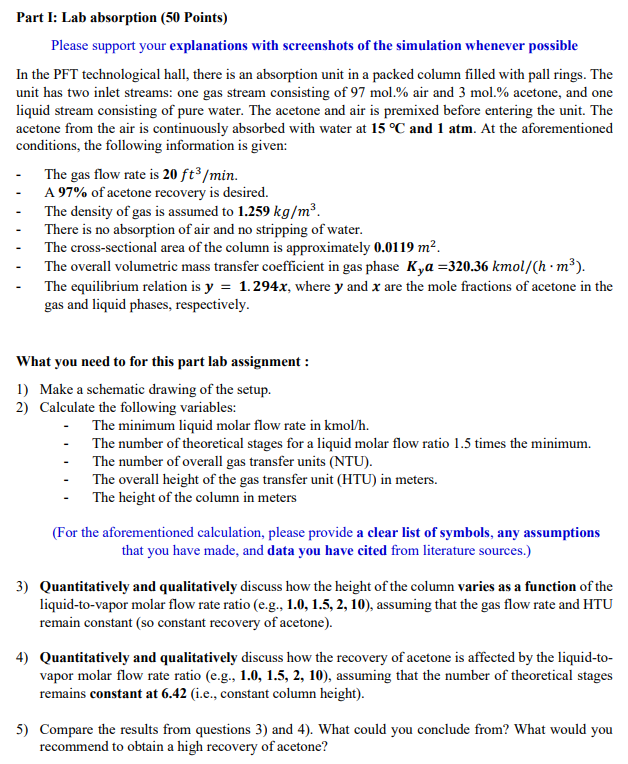Answered step by step
Verified Expert Solution
Question
1 Approved Answer
Please explain this question and solve : Part I: Lab absorption Please support your explanations with screenshots of the simulation whenever possible In the technological
Please explain this question and solve :
Part I: Lab absorption
Please support your explanations with screenshots of the simulation whenever possible
In the technological hall, there is an absorption unit in a packed column filled with pall rings. The unit has two inlet streams: one gas stream consisting of mol. air and mol. acetone, and one
liquid stream consisting of pure water. The acetone and air is premixed before entering the unit. The acetone from the air is continuously absorbed with water at and atm. At the aforementioned
conditions, the following information is given:
The gas flow rate is
A of acetone recovery is desired.
The density of gas is assumed to
There is no absorption of air and no stripping of water.
The crosssectional area of the column is approximately
The overall volumetric mass transfer coefficient in gas phase
The equilibrium relation is where and are the mole fractions of acetone in the gas and liquid phases, respectively.
Make a schematic drawing of the setup.
Calculate the following variables:
The minimum liquid molar flow rate in
The number of theoretical stages for a liquid molar flow ratio times the minimum.
The number of overall gas transfer units NTU
The overall height of the gas transfer unit HTU in meters.
The height of the column in meters
For the aforementioned calculation, please provide a clear list of symbols, any assumptions that you have made, and data you have cited from literature sources.
Quantitatively and qualitatively discuss how the height of the column varies as a function of the liquidtovapor molar flow rate ratio eg assuming that the gas flow rate and HTU
remain constant so constant recovery of acetone
Quantitatively and qualitatively discuss how the recovery of acetone is affected by the liquidtovapor molar flow rate ratio eg assuming that the number of theoretical stages
remains constant at ie constant column height
Compare the results from questions and What could you conclude from? What would you recommend to obtain a high recovery of acetone?

Step by Step Solution
There are 3 Steps involved in it
Step: 1

Get Instant Access to Expert-Tailored Solutions
See step-by-step solutions with expert insights and AI powered tools for academic success
Step: 2

Step: 3

Ace Your Homework with AI
Get the answers you need in no time with our AI-driven, step-by-step assistance
Get Started


